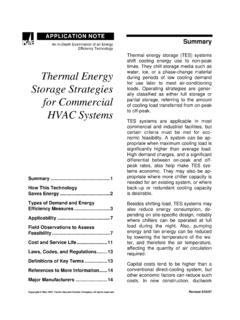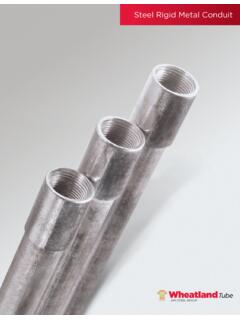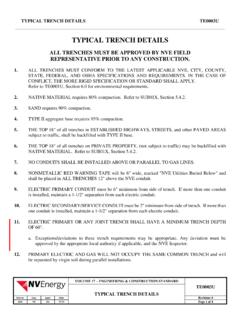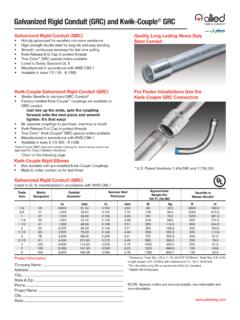Transcription of 062288 - Underground Conduits - Pacific Gas and Electric ...
1 UG-1: ConduitsGreenbookRev. #19: 12-17-20062288 Page 1 of 22 Electric Distribution062288 Function:Asset Type:Issued by:Date:12-17-20 Rev. #19: This document replaces PG&E Document 062288 , Rev. #18 For a description of the changes, see Page CONDUITSP repared by: ABB1 Design and ConstructionLisseth Villareal (LDV2)Purpose and ScopeThis document covers steel and plastic conduit for Electric Underground installations, with or without concrete Information1. Applications for Underground conduit are as follows:A.
2 Residential: All residential installations requiring conduit should be made without concrete Light Commercial, Industrial, and Underground Residential Distribution (URD) Feeder: Installation of circuits ofthis type, which are three-way or less, should normally be made without concrete encasement. In denselypopulated urban areas, conduit banks involving more than three primary Conduits will normally requireconcrete Severe exposure to dig-ins and other hazards may require concrete encasement of conduit In April of 2020, PG&E stopped purchasing rigid PVC DB-120 for Conduits , couplings, fittings, and bends forinstallation in its Electric distribution system.
3 PG&E now purchases rigid single wall or co-extruded cellular corewall PVC Schedule 40 Conduits , couplings, rigid single wall or co extruded cellular core wall PVC Schedule 40 Conduits , couplings, fittings, and bendsare interchangeable with rigid PVC DB-120 Conduits , couplings, fittings, and bends, respectively. Thisinterchangeability is possible because DB-120 and rigid PVC Schedule 40 materials have the same When conduit , including service conduit , is to be installed for PG&E by others, the Conduits must meet therequirements listed in this document.
4 The conduit listed below are also acceptable alternatives to the requiredRigid single wall or co extruded cellular core wall PVC Schedule Single wall and co extruded cellular core wall PVC Schedule 80, UL 651 conduit that is so Hot-dip galvanized rigid steel conduit conforming to American National Standards Institute (ANSI)Specification is the installer s responsibility to use the proper fitting to join Conduits . This transition may involve changes inboth conduit type and size. If equal diameter Conduits of different wall thicknesses are joined, the inside edgeof the spigot end must be The current carrying capacity of an insulated cable is reduced if it is surrounded by other loaded cables.
5 Forthis reason, conduit banks should be arranged so that each conduit is in an outside Every effort should be made to obtain a straight, watertight conduit In commercial distribution systems, consideration should be given to providing one or more spare Conduits inthe original construction for future load growth requirements. The addition of such Conduits at a later time ismuch more A mandrel must be used to prove that all Conduits are free and clear of dirt, rocks, and other debris. Forfurther information refer to Greenbook A pulling tape with sequential footage markings (Material Code M560154) must be installed in all conduitsand attached to an end cap.
6 The tape must be proven free and not glued or caught on : ConduitsGreenbookUnderground ConduitsRev. #19: 12-17-20062288 Page 2 of 2210. All Conduits must be capped. All Conduits not terminating in a subsurface enclosure, pedestal, or vault are tobe capped with unglued rigid caps (see Table 12 on Page 8). Conduits terminating in a subsurface enclosure,pedestal, or vault must be capped with temporary plugs (see Table 12 on Page 8).11. When the intrusion of water into buildings can be reasonably expected through lateral service ducts, PG&E isresponsible for sealing both ends of the conduit (refer to Document 063927 and Document 063928).
7 TheRayflate Duct Sealing System (RDSS) conduit sealing system can be ordered for this purpose. RDSS must beused when waterproofing a subsurface transformer enclosure is required. Refer to Document For the minimum design requirements of Conduits installed in PG&E Electric distribution system see For the design requirements of Conduits installed specifically on bridges see Utility Procedure Specifications14. Plastic Conduits and fittings must comply with the following industry specifications:A. Tensile modulus of 500,000 National Electric Manufacturers Association (NEMA): NEMA TC-2 for straight conduit , couplings and NEMATC-3 for fittings and Underwriters Laboratory (UL).
8 UL 651 or Electrical Testing Labs (ETL) that conforms to UL UL 651 or ETL conforms to UL 651 must be marked on the outside wall of the PVC schedule rigid solid and single wall or co-exruded cellular core wall PVC Schedule 40 Conduits , couplings, fittings, andbends must be gray in Marking must conform to UL 651 Plastic conduit may be cut with a hacksaw or a fine-toothed wood saw. Clean off burrs. Bevel the inside toeliminate sharp Apply a thin, uniform coat of cement to both surfaces to be glued. Avoid excessive use of cement to prevent theformation of a bead of cement on the interior shoulder of the joint since, when hardened, the bead can causecable damage during installation.
9 Immediately after applying the coat of cement to the conduit , insert the conduitinto the fitting socket until it bottoms at the fitting shoulder. Turn the conduit 1/4 turn during insertion to distributethe cement evenly. Hold the conduit in place for about 1 minute to prevent backing out in case of tight interferencefit joints. Wipe any excess cement away from the outside of the joint. Weather conditions may vary the curingtime. When using cement in confined areas, adequate ventilation must be 1 Cement for Use With Plastic ConduitsApplicationQuantityApproved Manufacturer and Part NumberMaterial CodeOateyWeld-on Duit 413 PVC to PVC1 Quart30886120894901571 Pint308851209049015117.
10 Backfill containing large rock, paving material, cinders, large amounts of sharply angular substance, orcorrosive material must not be placed in excavations where such material may damage Conduits , preventadequate compaction of the fill, or contribute to corrosion of the Use end bells to terminate all Conduits , unless the conduit has been terminated in an enclosure equipped withduct terminators. Use cable protectors on reconstruction projects only, when end bells cannot be In applications where a conduit dead-ends, cap the end of the conduit and place a marker ball (material code M374947) at the location.















